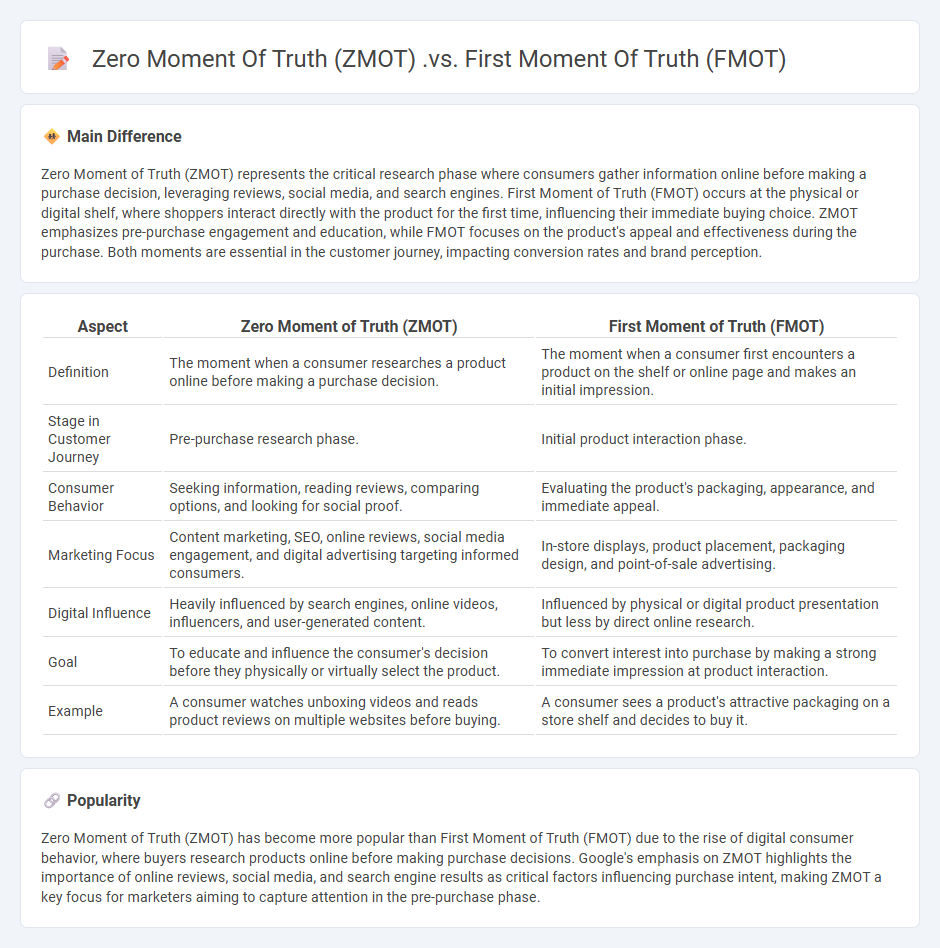
Zero Moment of Truth (ZMOT) represents the critical research phase when consumers actively seek information online before making a purchase decision. In contrast, the First Moment of Truth (FMOT) occurs when shoppers encounter a product on the store shelf or website, prompting immediate buying behavior. Explore the distinct impact of ZMOT and FMOT on consumer journey optimization to boost marketing effectiveness.
Main Difference
Zero Moment of Truth (ZMOT) represents the critical research phase where consumers gather information online before making a purchase decision, leveraging reviews, social media, and search engines. First Moment of Truth (FMOT) occurs at the physical or digital shelf, where shoppers interact directly with the product for the first time, influencing their immediate buying choice. ZMOT emphasizes pre-purchase engagement and education, while FMOT focuses on the product's appeal and effectiveness during the purchase. Both moments are essential in the customer journey, impacting conversion rates and brand perception.
Connection
Zero Moment of Truth (ZMOT) occurs when consumers research products online before purchase, gathering reviews and information to form opinions. First Moment of Truth (FMOT) happens when consumers first encounter the product in-store or on a website, influenced by their ZMOT research. The connection lies in ZMOT shaping consumer expectations and decision-making, which directly impacts the success of FMOT during the buying experience.
Comparison Table
| Aspect | Zero Moment of Truth (ZMOT) | First Moment of Truth (FMOT) |
|---|---|---|
| Definition | The moment when a consumer researches a product online before making a purchase decision. | The moment when a consumer first encounters a product on the shelf or online page and makes an initial impression. |
| Stage in Customer Journey | Pre-purchase research phase. | Initial product interaction phase. |
| Consumer Behavior | Seeking information, reading reviews, comparing options, and looking for social proof. | Evaluating the product's packaging, appearance, and immediate appeal. |
| Marketing Focus | Content marketing, SEO, online reviews, social media engagement, and digital advertising targeting informed consumers. | In-store displays, product placement, packaging design, and point-of-sale advertising. |
| Digital Influence | Heavily influenced by search engines, online videos, influencers, and user-generated content. | Influenced by physical or digital product presentation but less by direct online research. |
| Goal | To educate and influence the consumer's decision before they physically or virtually select the product. | To convert interest into purchase by making a strong immediate impression at product interaction. |
| Example | A consumer watches unboxing videos and reads product reviews on multiple websites before buying. | A consumer sees a product's attractive packaging on a store shelf and decides to buy it. |
Consumer Decision Journey
The Consumer Decision Journey outlines the stages customers go through from initial awareness to post-purchase evaluation, influencing marketing strategies across all touchpoints. Key phases include consideration, evaluation of alternatives, purchase decision, and loyalty formation, with digital channels playing a critical role in each step. Brands leverage data analytics and personalized content to tailor messaging and enhance customer experience throughout this journey. Understanding these dynamics helps marketers optimize engagement, boost conversion rates, and foster long-term brand advocacy.
Online Research Behavior
Online research behavior in marketing involves consumers actively seeking product information, comparing brands, and reading reviews before making a purchase decision. According to a 2023 study by Statista, 87% of buyers use online resources to research products prior to shopping. This behavior significantly impacts digital marketing strategies, emphasizing SEO optimization, targeted content creation, and influencer partnerships. Marketers leverage data analytics to track search patterns and tailor personalized experiences that increase conversion rates.
Point of Purchase
Point of Purchase (POP) refers to the location or moment where a consumer completes a purchase decision, often within a retail environment. Effective POP marketing uses strategically placed displays, signage, and promotions to capture attention and influence buying behavior at the critical time of sale. In 2023, global retail POP displays were projected to reach a market value of approximately $21 billion, driven by increasing demand for in-store experiential marketing. Brands leverage POP to enhance product visibility, boost impulse purchases, and improve customer engagement in high-traffic retail settings.
Pre-Purchase Engagement
Pre-purchase engagement in marketing involves interactions between consumers and brands before a buying decision is made, focusing on building awareness and interest. Techniques such as targeted content marketing, social media campaigns, and personalized email outreach increase consumer involvement and influence purchase intent. Data-driven approaches using customer behavior analytics enhance engagement strategies by tailoring messages to individual preferences. Effective pre-purchase engagement can significantly improve conversion rates and foster long-term customer relationships.
Influencer Touchpoints
Influencer touchpoints refer to the critical moments when brands interact with their target audience through influencers across various digital platforms, including Instagram, TikTok, YouTube, and blogs. Effective influencer marketing strategies leverage these touchpoints to create authentic engagement, drive brand awareness, and increase conversion rates. Data from Statista reveals that 75% of marketers intend to boost their influencer marketing budgets in 2024, emphasizing the importance of optimizing these touchpoints for maximum impact. Metrics such as reach, engagement rate, and follower growth are essential for evaluating the success of influencer touchpoints in marketing campaigns.
Source and External Links
Here are three sets of answers comparing Zero Moment of Truth (ZMOT) and First Moment of Truth (FMOT):RTB House - ZMOT vs FMOT - ZMOT is the moment when customers research a product online before purchase, while FMOT is the moment when they first physically interact with it.
Optimize Smart - ZMOT vs FMOT - ZMOT occurs after brand exposure but before purchase, involving research, while FMOT is the initial encounter with the product at the point of sale.
Amati and Associates - ZMOT vs FMOT - ZMOT is about online research, while FMOT is the decision point at the place of purchase or online.
 calledges.com
calledges.com